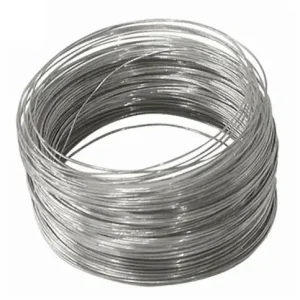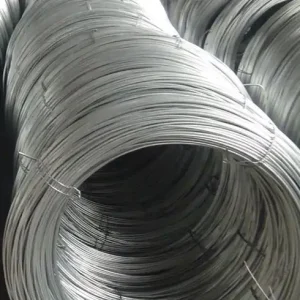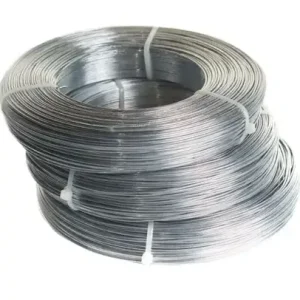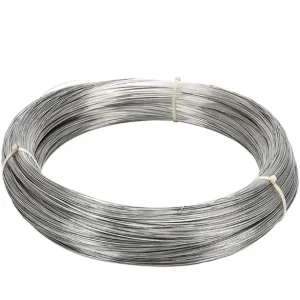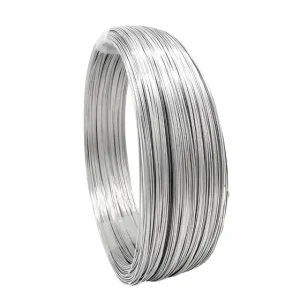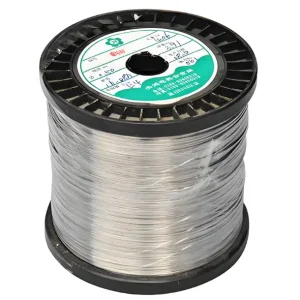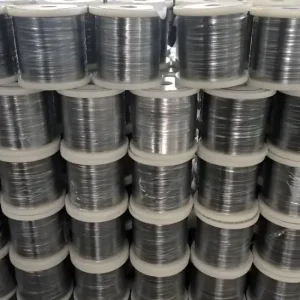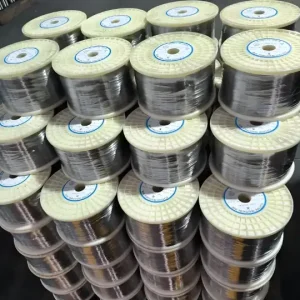Alloy Wires
Products
Nickel alloy wires are premium, nickel-rich metallic conductors engineered for high corrosion resistance, elevated-temperature strength, and dimensional stability; they serve critical functions in aerospace, chemical processing, energy, heating elements, and marine systems where ordinary steels or copper alloys fail.
What is Nickel Alloy Wire?
Nickel alloy wire is a family of drawn or cold-worked wires made from nickel-based or nickel-bearing alloys. Unlike general purpose wires (copper, mild steel), these alloys are formulated to resist aggressive chemicals, high temperatures, thermal cycling, and fatigue. They may be supplied as coils, spools, straight lengths or formed components, and are available in a wide range of diameters and tolerances for precision engineering uses.
What is the chemical composition of Nickel Alloy Wire?
Below are representative compositions for some widely used nickel wire alloys. These are typical ranges; exact composition depends on specification and producer.
| Alloy / Trade name | Main elements (wt%) — typical |
|---|---|
| Inconel 625 (N06625) | Ni balance; Cr ~20–23; Mo ~8–10; Nb+Ta ~3–4; Fe ≤5; minor C, Mn, Si. |
| Monel 400 (UNS N04400) | Ni ~63–70; Cu ~28–34; Fe ≤2.5; Mn ≤2; Si ≤0.5; C ≤0.3. |
| Incoloy 800 / 800H | Ni ~30–35; Fe ~39–46; Cr ~19–23; small C, Al, Ti. |
| Nichrome 80/20 (NiCr 80/20) | Ni ~75–80; Cr ~19–21; small Fe, C, Si, Mn. |
| Hastelloy C-type (e.g., C276) | Ni balance; Mo ~15–17; Cr ~14–17; Fe ≤4; W, Co trace. |
Notes: individual datasheets give precise min/max values and trace elements for each UNS or trade designation. Representative datasheets and manufacturer technical bulletins should be consulted for final engineering selection.
What are the mechanical properties of Nickel Alloy Wire?
Mechanical properties depend on alloy, heat-treatment and cold-work level. The following table gives typical annealed or commercial-condition ranges for common alloys used in wire form.
| Alloy | Typical tensile strength (MPa) | Yield (0.2% offset) (MPa) | Elongation (%) |
|---|---|---|---|
| Inconel 625 (annealed) | ~690–880 MPa | ~240–410 MPa | 30–50% |
| Monel 400 (annealed) | ~450–620 MPa | ~120–300 MPa | 40–60% |
| Nichrome 80/20 (resistance wire) | ~600–900 MPa (depends on cold work) | varies widely | 10–30% |
| Incoloy 800 | ~500–700 MPa | ~200–450 MPa | 30–50% |
Engineering note: cold drawing raises tensile strength and lowers elongation; design must account for that. For precise property tables by condition (annealed, cold-drawn, solution treated) consult supplier data sheets and MatWeb/manufacturer technical pages.
What is the specification of Nickel Alloy Wire?
Typical commercial specifications and physical ranges for wire supply:
| Item | Typical range / test |
|---|---|
| Diameters | 0.05 mm — 12.0 mm (special sections outside range) |
| Surface condition | Bright finish; chemically cleaned; oxide-free for welding/resistance wire |
| Tolerances | ±0.01 mm for fine wire; larger wires per ASTM/general industry tables |
| Forms | Spool/coil, straightened lengths, rings |
| Heat treatment | Annealed, stress-relieved, solution-treated (per alloy) |
| Traceability | Mill test certificate (MTC), heat number, lot ID |
| Common specs | ASTM B164 (Monel and some nickel-copper wires), ASTM/ASME codes for bars/rods, specific manufacturer standards. |
(Always confirm the required ASTM/UNS/EN designation when specifying wire to ensure weldability, corrosion resistance and mechanical performance.)
What does “Nickel Alloy Wire” stand for?
In procurement language it denotes wire produced from nickel-based alloys (a family defined by high nickel content and particular alloying elements) and intended for applications where nickel’s properties (corrosion resistance, temperature stability) are essential. It signals both chemical family and intended performance class, and usually implies higher unit cost than ferrous or copper wire.
What is a Nickel Alloy Wire used for?
Short, practical uses:
-
Heating elements and resistance wire (NiCr).
-
High-temperature fasteners and springs.
-
Corrosion-resistant instrumentation and sensors.
-
Marine and subsea components (Monel).
-
Chemical processing plant internals, scrubbers, and piping components.
-
Aerospace control cables, springs and engineered components.
-
Nuclear and power generation specialty wiring in critical circuits.
What is the classification of Nickel Alloy Wire?
| Classification axis | Typical categories |
|---|---|
| By base chemistry | Ni-Cr, Ni-Cu (Monel), Ni-Fe-Cr (Incoloy), Ni-Mo-Cr (Hastelloy/Inconel families) |
| By use case | Resistance heating, corrosion service, high-temperature structural, electrical contacts |
| By manufacturing | Cold-drawn precision wire, bright annealed wire, oxidized resistance wire |
| By standard | UNS/EN/ASTM designations (e.g., UNS N06625, N04400, W.nr 2.4856) |
Nickel Alloy Wires — common grades (table)
| Commercial name | UNS / common code | Typical strengths | Typical uses |
|---|---|---|---|
| Inconel 625 | UNS N06625 | High strength, excellent corrosion and creep resistance | High-temp fasteners, marine, chemical |
| Inconel 718 | UNS N07718 | High strength at elevated temp | Aerospace springs, high-stress parts |
| Monel 400 | UNS N04400 | Excellent seawater resistance | Marine hardware, valves, shafts |
| Monel K-500 | UNS N05500 | Precipitation-hardenable, high strength | Shafts, couplings, seawater components |
| Nichrome 80/20 | (resistance wire) | High resistivity, oxidation resistant | Heating elements, resistors |
| Hastelloy C276 | UNS N10276 | Outstanding corrosion resistance in harsh chemistries | Chemical process plant components |
(Selection depends on chemical environment, mechanical load, temperature range and manufacturability. For nuclear or medically critical uses additional approval and traceable certifications are required.)
Nickel Alloy Wires — global market prices (2025) — comparative table
Important: metal markets fluctuate with raw-material nickel prices, alloy content, certification, product form and order volume. The table below gives indicative range values collected from market price summaries (retail/industrial supplier ranges for small-to-medium purchases in 2025). Use this only for budgeting; request formal quotes for procurement.
| Alloy | Typical 2025 price range (USD / kg) — indicative |
|---|---|
| Inconel 625 (wire/rod form) | $45 — $85 / kg. |
| Inconel 718 | $40 — $80 / kg (depends on form and certification). |
| Monel 400 | $18 — $40 / kg (Ni-Cu content makes it cheaper than Ni-Mo alloys). |
| Nichrome 80/20 (resistance wire) | $8 — $25 / kg (volume & temper drive price). |
| Hastelloy C276 (wire/rod) | $60 — $120 / kg (high alloying with Mo, W raises cost). |
Price notes: these ranges reflect market reports and supplier lists in 2025; actual delivered cost will include minimum order, machining, certification (e.g., NDT, MTC), and transport. For contract projects in the Gulf or Europe, add freight, duties and possible import certification.
Nickel Alloy Wires — technical advantages
-
Corrosion endurance: resists acids, seawater and many aggressive media where stainless steels corrode.
-
Temperature stability: preserves mechanical performance at high temperatures (some alloys to >1000°C in service).
-
Dimensional control: cold-drawn wire achieves tight diameter tolerances and stable springs/sensor elements.
-
Weldability / joinability: many nickel alloys weld well with appropriate filler and procedures.
-
Lifecycle economy: initial material premium often offset by lower maintenance and longer service life in harsh environments.
Illustrative procurement case — Qatar
Context: Municipal desalination plant retrofit required resistance to brackish seawater, high chloride stress and cyclic thermal load. Client requested wire for custom heater elements and fasteners inside brine handling modules.
Procurement highlights (anonymized):
-
Alloy choice: Monel 400 for seawater-exposed fasteners; Inconel 625 for high-stress, corrosion-prone heater mounts.
-
Certs required: full MTC to EN 10204 3.1, PMI or spectral analysis on shipment, batch traceability.
-
Volume & packaging: 500 kg coils of resistance wire; 200 kg of 2.5 mm drawn wire for fasteners. Packaged with desiccant in sealed reels for marine shipment.
-
Quality checks performed: dimensional check, tensile test samples, surface visual and eddy current pass for continuity.
-
Logistics & delivery: export documentation for Qatar customs, pre-inspection by buyer’s third-party representative.
Lessons for buyers: specify environment (temperature, chloride content), insist on MTC and heat number traceability, and allow supplier to propose alternate alloys if lead time for a specific UNS is long. This is an illustrative, anonymized case that reflects common procurement practice rather than a public project disclosure.
Technical standards and authoritative references
Commonly referenced standards and norms for nickel alloy wire procurement and testing:
-
ASTM B164 — Nickel-Copper alloy rod, bar and wire (used for Monel types).
-
UNS / EN designations — use UNS codes (e.g., N06625) and national standards for interchange.
-
Manufacturer technical bulletins — e.g., Special Metals product sheets for Inconel/Monel offer composition and handling guidance.
(When specifying material for critical service, include required tests: tensile, PMI/spectral analysis, hardness, and NDT if applicable.)
Handling, forming and joining notes
-
Drawing & spring forming: use progressive dies and controlled lubrication; warm forming may be needed for high-alloy grades.
-
Welding: use matching filler metals and qualified procedures; chloride environments require correct post-weld heat treatment for some alloys.
-
Annealing: follow supplier’s time-temperature practice to restore ductility after heavy cold work.
-
Surface: bright anneal for electrical/resistance applications; oxide-free for plating or brazing.
Storage, inspection and traceability best practice
-
Store in dry, labeled containers with MTC attached.
-
Maintain heat number traceability from mill to finished part.
-
Implement incoming inspection: diameter, surface, certificate verification, and random tensile tests if project critical.
-
For marine or chemical projects require additional corrosion coupons or immersion checks when requested.
FAQs
Q1: Can nickel alloy wire be galvanized or plated?
A1: Plating is possible (e.g., silver, copper) but compatibility must be checked; some nickel alloys form stable oxides that inhibit adhesion—surface prep and vendor guidance are essential.
Q2: Which nickel wire is best for heating elements?
A2: Nichrome (Ni-Cr alloys, e.g., 80/20) is optimized for high resistivity and oxidation resistance and is the standard for most resistance heaters.
Q3: Are nickel alloy wires magnetic?
A3: Most nickel-based alloys are essentially non-magnetic in the annealed condition; however certain cold-worked conditions or specific Fe content can induce slight magnetic response.
Q4: How do I specify tolerance for precision wire?
A4: Specify nominal diameter, tolerance (e.g., ±0.01 mm for sub-1 mm wire), maximum out-of-roundness, and surface finish; ask supplier for their diameter table.
Q5: Do nickel alloys need special welding procedures?
A5: Many do. Use matching filler metal, control heat input, and follow recommended post-weld treatment where required. Procedure qualification is recommended for critical parts.
Q6: What inspections are typical on delivery?
A6: Mill test certificate (MTC), visual inspection, diameter check, and optionally tensile tests and PMI for alloy verification.
Q7: Is nickel wire recyclable?
A7: Yes — nickel alloys have significant scrap value and can be recycled, but segregation of alloy type is necessary to avoid contamination.



